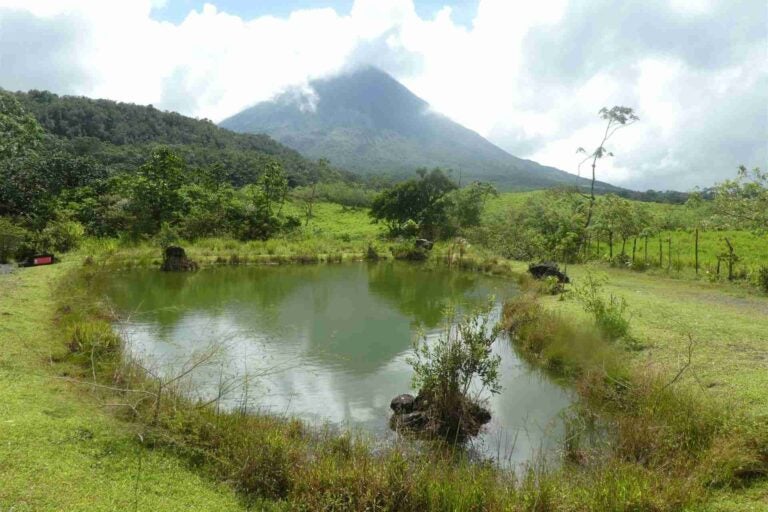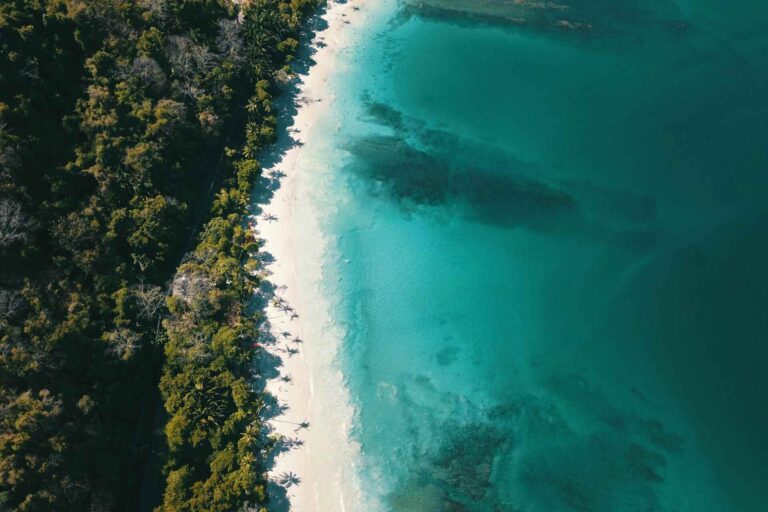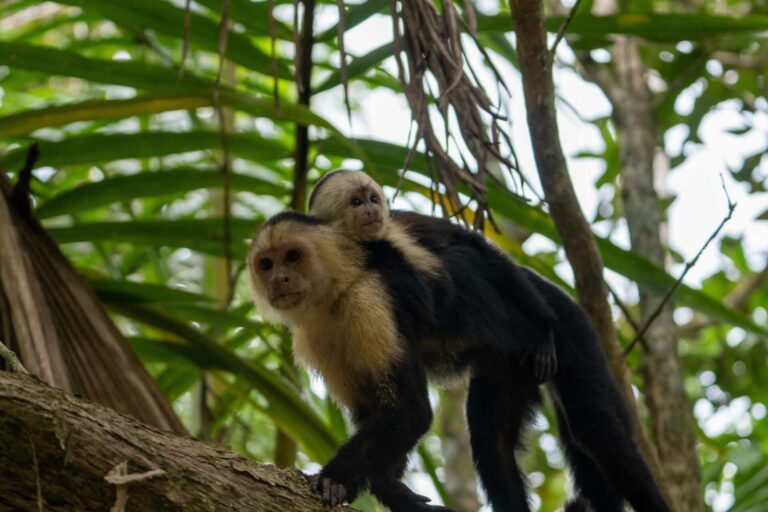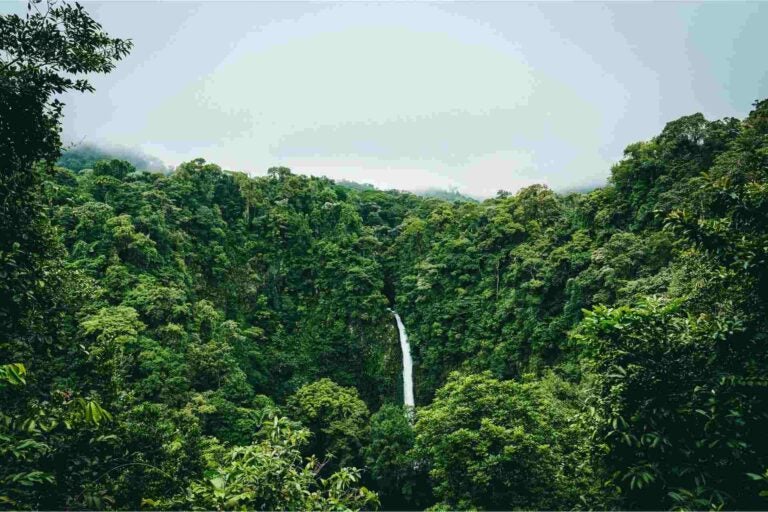What is Costa Rica known for? 10 Famous things
Costa Rica is known for its abundant wildlife, breathtaking nature, unique culture, and relaxed way of life, often referred to as pura vida.
Costa Rica is known for its biodiversity, tropical climate, beaches, and culture. This makes it a popular holiday destination, with millions of tourists visiting the country each year. Follow along to learn more about what Costa Rica is known for to ensure you don’t miss out on key experiences when you visit.
Exploring Costa Rica’s famous landscapes is much easier with reliable mobile internet. Stay connected with a Holafly eSIM for Costa Rica and enjoy unlimited data and solid coverage throughout your stay.
1. Sloths
To many, sloths are synonymous with Costa Rica, and the popularity of sloths on the internet makes this bond even stronger. Two-toed and three-toed sloths can both be found here, though locating them in the dense rainforest canopy isn’t an easy task.
Thankfully, there are several wildlife sanctuaries in Costa Rica that make it easier for you to get close and personal with these charming animals.
That said, observing sloths isn’t exciting for long, as they spend a majority of their day sleeping, with the remaining few hours dedicated towards eating, mating, and resting. Not a bad way to live.

2. Coffee
Costa Ricans sure love their coffee. So much so, in fact, that farmers are required by law to only plant high-quality Arabica beans. Costa Rican coffee is grown in the mountainous regions of the country, where plants get enough humidity, shade, and slightly cooler temperatures, allowing them to thrive.
If you have the time, consider booking one of many guided tours. Since the coffee plantations are located in some of the most stunning areas of the country, you get to explore Costa Rican culture and nature all at once.

3. Volcanoes
There are over 60 volcanoes in Costa Rica. And while most of them are dormant, a few are still very much active. Poas, Arenal, Irazu, Turrialba, and Rincon de la Vieja are the five active volcanoes in the country, with Poas being the most active, last erupting in 2017.
The bubbling, steaming craters are a big tourist draw and are generally considered safe to visit since most eruptions can be predicted in advance nowadays. The Irazu Volcano National Park and Poas Volcano National Park are two of the top destinations to visit if you want to step foot on the edge of an active volcano yourself.

4. Cerro Chirripó
Cerro Chirripó is Costa Rica’s highest peak and the fourth-highest peak in Central America, standing at 12,536 feet (3,821 meters) tall. It gathers hikers, birdwatchers, and camping enthusiasts from all over. That said, if you want to try and tackle the peak itself, you must hire a guide and get a permit. Otherwise, you’re not allowed to climb the mountain.
The hike up the mountain isn’t particularly technical, but it is physically challenging. Most hikers take two to three days to tackle the 25-mile (40-kilometer) roundtrip. So make sure you have enough mountaineering experience and good general fitness before taking on the route.

5. Beaches
With the Pacific Ocean to the west and the Caribbean Sea to the east, Costa Rica has no shortage of sandy beaches, palm trees, and crystal-clear waters. The low elevation means that the coasts are typically the warmest places in Costa Rica, allowing you to catch a tan nearly all year round.
On top of basking in the sun, the beaches are also home to four species of sea turtles who come ashore to lay their eggs. Some of the most popular beaches include Playa Conchal and Playa Guiones on the Pacific coast and Cahuita, Punta Uva, and Puerto Viejo de Talamanca on the Caribbean coast.

6. National parks
Costa Rica is home to 32 incredible national parks, each with its own unique flora and fauna. Visiting them is a great way to truly uncover the natural beauty of the country, and with multiple parks within a couple of hours drive from San José, there’s no good reason for you not to dedicate a day or two of your vacation to exploring Costa Rica’s national parks.
Popular tourist destinations include the Carrara National Park, the Cahuita National Park, the Central Valley, and the aforementioned Irazu and Poas Volcano National Parks. That said, there’s hardly a bad choice to explore.

7. Hearty foods and tropical fruits
No Costa Rican experience is complete without mentioning Costa Rican cuisine. The regular local diet consists largely of hearty foods and tropical fruits, all of which are a true treat to your taste buds.
Some of the local favorites include gallo pinto (rice and beans), ceviche (seafood salad), olla de carne (beef and veggie stew), Chifrijo (a mix of pico de gallo, beans, rice, pork, and avocado, served with tortilla chips), Arroz con Leche (rice pudding, and fruits such as mango, rambutan, guanabana, and pitaya.
Trying local food is essential for truly getting to know the country. Take a break from your regular comfort foods and dive into the flavorful world of Costa Rican food.

8. Chocolate
While it can be attributed to Costa Rican cuisine, chocolate definitely deserves a separate mention here. Chocolate has been a part of Central American culture ever since Aztec times and is still a big part of Costa Rican identity today.
Costa Rican chocolate beans are valued for their quality worldwide. You can even still find indigenous tribes growing cacao beans on indigenous land, just as they did centuries ago. Consider taking a tour of an indigenous chocolate plantation while here. It’ll help you truly understand what quality chocolate is and how it’s grown.

9. Pura Vida
Pura Vida is a phrase you’ll hear a lot in Costa Rica. It translates directly to “pure life,” but it can mean “thanks,” “don’t worry about it,” or even simply “hello.” The phrase perfectly encapsulates the way of life in the country and the mindset of the people here. Life here is pure and lived in harmony with the world around you.

10. Outdoor activities
With so many different landscapes and terrains, it is no surprise that outdoor activities and ecotourism are extremely popular in Costa Rica. The most popular activities include hiking, canoeing, canal exploration, horseback riding, rafting, and zip lining.
All are often combined with wildlife exploration, as getting off the beaten path enhances your chances of seeing some of Costa Rica’s iconic animals.

Tips for a quality Costa Rican experience
Costa Rica sure has plenty to offer, and you’re nearly guaranteed to have a great time. However, there are some things that can make your visit even easier and more enjoyable. Here’s a quick Costa Rica travel guide to help you get ready for your trip.
- Get some cash — you may not have issues paying by card in some more popular areas around San Jose, but cash is king in many small towns and villages. Colón is Costa Rica’s currency, but US dollars are also accepted pretty much everywhere.
- Embrace the culture — it’s comfortable to only eat the food that you know and do the things that you’ve done before. But to truly experience Costa Rica, you need to embrace the pura vida lifestyle yourself. Try the local food, do exciting activities, and spend your time in a way that won’t make you regret not doing something later.
- Check visa requirements — check whether or not you need a visa to enter before your trip. If you do, sort it out in advance. You don’t want to get all the way to the airport with your bags packed for Costa Rica only to be turned around because you didn’t have a visa.
- Mind the hurricane season — hurricane season in Costa Rica lasts from July through November. It doesn’t mean that you won’t be able to step foot outside of your hotel room but you should expect more rain, heat, and humidity. On the plus side, there are fewer tourists at this time, leading to cheaper prices and quieter surroundings.
- Prepare for the elements — you’re likely to get a lot of sun when visiting Costa Rica, so make sure to apply sunscreen generously to avoid getting sunburnt. Mosquitos and other bugs can also be an issue, especially when humidity is high, making bug spray your best friend for the duration of your visit.
- Get mobile internet — having mobile internet makes your Costa Rica experience much easier. It allows you to use translation apps, find your way around with map apps, or stay in touch with friends and family back home. Local Costa Rica SIM cards, eSIMs, and pocket WiFi devices for Costa Rica are all viable options. That said, using an eSIM is the most convenient and often the most affordable way to stay online.
Experience what Costa Rica is known for first-hand with Holafly
Holafly offers some of the best eSIMs for Costa Rica, with each having unlimited data, hotspot sharing, and 24/7 customer support. Choose any number of days from 1 to 90 to match your eSIM with your holiday, and avoid paying for any days you don’t need.
Enjoy complete peace of mind with Holafly’s eSIM for Costa Rica. You’ll never lose connection and that help is never more than a couple of clicks away if you ever need it.
If you plan on staying longer or living a digital nomad life in Costa Rica, Holafly Connect offers an eSIM subscription that’ll keep you covered in 170+ countries. Simply choose a plan that suits your needs and stay online no matter where you go.





 Language
Language 


















 No results found
No results found












